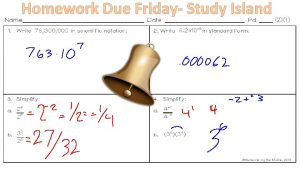Announcements Homework 4 Due on Friday Last Time



















- Slides: 19

Announcements • Homework 4 Due on Friday

Last Time Generating Functions • {an} → a 0 + a 1 x + a 2 x 2 + a 3 x 3 + … • Can be used to reduce combinatorial problems about an to algebraic problems about f. • Recurrence Relations: Give an in terms of previous values.

Basic Tools • If two generating functions are the same, the coefficients are the same: If Σn anxn = Σn bnxn then an = bn for all n. • Geometric series: 1/(1 -cx) = Σn (cx)n = Σn cn xn. • Sums of Generating Functions: (Σn an xn) + (Σn bn xn) = Σn (an + bn) xn • Shifts: If F(x) = Σn an xn, x. F(x) = Σn an xn+1 = Σn>0 an-1 xn.

Partial Fractions Given a generating function F(x) = p(x)/q(x) with p(x) and q(x) polynomials, how do we find a formula for the coefficients? 1) Reduce p: Write F(x) = r(x) + p 0(x)/q(x) with degree(p 0) < degree(q). 2) Factor q: Write q(x) = (x-r 1)(x-r 2)…(x-rk). 3) Rewrite: Write p 0(x)/q(x) as A 1/(x-r 1) + A 2/(x-r 2) + … + Ak/(x-rk) [You can always do this if q has distinct roots, otherwise, it is a bit more complicated].

Partial Fractions 4) Get Formula: Note that: 1/(x-ri) = (-1/ri) / (1 -x/ri) = -(1/ri) - (1/ri)2 x - (1/ri)3 x 2 + … Adding terms together A 1/(x-r 1) + A 2/(x-r 2) + … + Ak/(x-rk) = Σn – (A 1/r 1 n+1 + A 2/r 2 n+1 + … + Ak/rkn+1)xn

Today • Solving Recurrence Relations • Products of Generating Functions

To Solve Simple Recurrence Relations 1) Define generating function F(x). 2) Use recurrence relation to relate F(x) to shifted generating functions. 3) Solve for F(x) as a rational function. 4) Compute a partial fraction decomposition. 5) Use to obtain a formula for coefficients.

Example: Fibonacci Numbers The Fibonacci Numbers are a sequence defined by: f 0 = f 1 = 1, and. fn+2 = fn+1 + fn for n ≥ 0. Let F(x) = Σn fn xn be the generating function.

Generating Function Recurrence says: (fn+2 – fn+1 – fn) = 0. So, Σn (fn+2 – fn+1 – fn)xn+2 = 0. • Σn fn xn+2 = x 2 F(x). • Σn fn+1 xn+2 = x(F(x) – f 0) = x. F(x) – x. • Σn fn+2 xn+2 = F(x) – f 0 – f 1 x = F(x) – 1 – x. Adding, (F(x) – 1 – x) – (x. F(x) – (x 2 F(x)) = 0. F(x)(1 – x 2) = 1. F(x) = 1/(1 – x 2).

Formula From here we can use partial fractions decomposition to get a formula for the coefficients. This is a bit complicated in this case since the roots of (1 -x-x 2) are irrational, but it is straightforward. Solving gives:

Example Consider the generating function (x/(1 -x))3 = (x+x 2+x 3+…)(x+x 2+x 3+…) = x 1+1+1 + x 1+1+2 + x 1+2+1 + x 2+1+1 + x 1+1+3 + x 1+2+2 + x 1+3+1 + x 2+1+2 + x 2+2+1 + x 3+1+1 + … Expanding out, we get the sum of xa+b+c over all triples of non-negative integers (a, b, c). What is the coefficient of xn in the resulting sum? The number of solutions to a+b+c = n. In other words the number of compositions of n into three parts.

Products of Generating Functions Let A and B be sets of non-negative integers and let f. A(x) = Σa∈A xa, f. B(x) = Σb∈B xb. Then, f. A(x)·f. B(x) = Σ xa+b = Σn xn #{a∈A, b∈B: a+b = n}. Coefficients of the product are the number of ways to write n as a sum of elements.

Example 1/(1 -x) = Σn≥ 0 xn. 1/(1 -x)k = Σn cn xn where cn is the number of ways to write n as the sum of k non-negative integers. In other words, cn is the number of weak compositions of n into k parts.

Taylor Expansion On the other hand, recall that (1+x)-k = Σn (-k)n xn/n! So the xn-coefficient is: (-k)(-k-1)(-k-2)…(-k-n+1)/n! = (-1)k (k+n-1)(k+n-2)…(k)/n! = (-1)k (k+n-1)Cn. Replacing x by –x, we find: (1 -x)-k = Σn (k+n-1)Cn xn. So the number of weak compositions of n into k parts is (k+n-1)Cn.

Example II An integer partition of n is a way of writing n as the sum of some number of 1 s plus some number of 2 s and so on. In other words, it’s the number of ways to write n as a 1 + 2 a 2 + 3 a 3 + … for non-negative integers ak. Note that: 1/(1 -xk) = Σa xka. So, 1/(1 -x)(1 -x 2)(1 -x 3)… = Σn p(n)xn.

General Products of Generating Functions A(x) = Σn an xn, B(x) = Σn bn xn. A(x)·B(x) = C(x) = Σn cn xn. What is cn? C(x) = (Σn an xn)(Σm bm xm) = Σn, m an bm xn+m = Σk xk (Σn+m=k an bm) ck = (Σn+m=k an bm).

Combinatorial Interpretation Suppose that you have objects of type-A and objects of type-B. Each has a size which is a non-negative integer, and there an objects of type-A of size n, and bm objects of type-B of size m. Then ck is the number of ways to find a pair of an object of type-A and an object of type-B where the sum of the sizes is k.

Example III You have an k-day period and want to divide it into two seasons. The first season should have one day selected as a holiday in it. Each day in the second season should be marked as either a work day or not. How many ways can you do this?

Example III (Continued) • First season has n days, second season has m days for some n+m = k. – First season has n ways to select a holiday. – Second season has 2 m ways to mark off workdays. Generating function: (x + 2 x 2 + 3 x 3 +…)(1 + 2 x + 4 x 2 + 8 x 3 + …) = (x/(1 -x)2)(1/(1 -2 x)) Using partial fractions, we find the xn coefficient here is 2 n+1 -n-1.
 Homework is due on friday
Homework is due on friday Homework is due on friday
Homework is due on friday If you had done your homework last night
If you had done your homework last night Homogenous
Homogenous What have you done last week
What have you done last week Did you finish your homework sally
Did you finish your homework sally What did you do in london last weekend
What did you do in london last weekend Pvu background
Pvu background R/announcements
R/announcements Church announcements
Church announcements Fahrenheit 451 pages
Fahrenheit 451 pages Kayl announcements
Kayl announcements General announcements
General announcements Homework oh homework
Homework oh homework Homework oh homework i hate you you stink
Homework oh homework i hate you you stink Parts of a poem
Parts of a poem Homework oh homework
Homework oh homework Homework oh homework i hate you you stink
Homework oh homework i hate you you stink Homework oh homework i hate you you stink
Homework oh homework i hate you you stink Homework due today
Homework due today





































